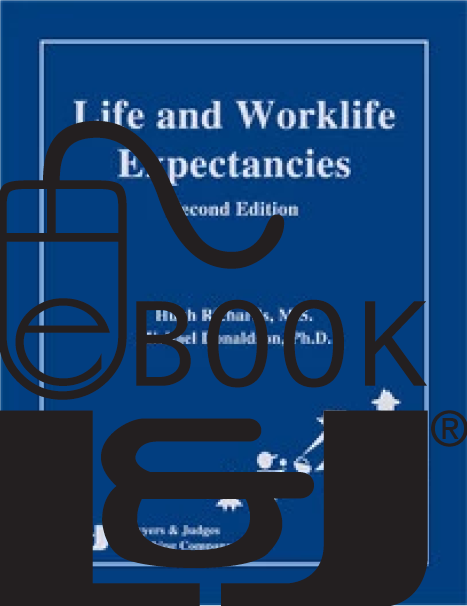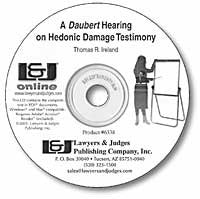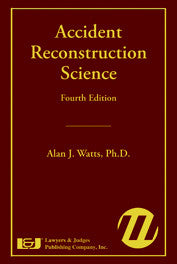
Life and Worklife Expectancies, Second Edition PDF eBook
- Author: Michael Donaldson, Hugh Richards
- ISBN 10: 1-933264-74-8
- ISBN 13: 978-1-933264-74-5
- Copyright Date Ed: January 1, 2010
- Pages: 243 pages
- PDF eBook
Now the information you need for determining life and worklife expectancies is in one complete volume right at your fingertips: smokers by education, many educational categories by race/Hispanic origin, persons with medical conditions, and more. Our brand new Life and Worklife Expectancies, Second Edition now features extensive life and worklife expectancy tables and figures in an easily accessible format.
Part I contains an overview of the methods and data sources used in life tables: differences between period and cohort life tables, properties of survival data, life expectancy by educational attainment, race/Hispanic origin, smoking status, relative mortality ratios for persons with medical risks, quality of care and life expectancy in cases of illness or disability, use of life annuities and structured settlements, calculation of retirement benefits, and more.
Part II addresses the main methods of determining duration of working life. Detailed tables for all methods and many educational, demographic, smoking status , occupational category, gender and race/Hispanic origin are provided. Biases are discussed and previous worklife estimates are corrected by including mortality rates by educational attainment. The increment-decrement model is carefully analyzed for correction of other potential biases. In addition, it discusses pros and cons of the various methods, for example worklife expectancies, Life-Participation-Employment (LPE) and Median Years to Retirement (MYR).
Part III contains comprehensive tables of life and worklife expectancies for the many demographics discussed in the text. This is the most complete overview of life and worklife expectancies for attorneys, insurance professionals, and forensic economists available anywhere.
Topics covered:
- Introduction to life tables and life expectancy
- Overview of life expectancies
- Cohort tables
- Current (period) tables
- Life expectancies for persons with medical risks
- Effects of cigarette smoking on life expectancy
- Life expectancy and the properties of survival data
- Bias and how to reduce or eliminate it
- Standard errors of estimates
- Introduction to estimates of working life
- Increment-decrement worklife expectancies by sex, race/Hispanic origin and education
- Conventional model worklife estimates by sex, race and education
- Hispanic worklife expectancies by education and English language proficiency
- Worklife expectancies by cigarette smoking status and education
- The life, participation, employment method
- Median years to retirement
- Issues in estimation of worklife
- Female labor force patterns
- Disabled persons
- Current and future trends of labor force participation
- Comparisons of methods
- Sample calculations and comparisons
- Comprehensive life and worklife expectancy tables
Table of Contents
List of Tables
Acknowledgments
PART I: LIFE EXPECTANCY
Chapter 1: Introduction
1.1 Overview
1.2 Introduction to Part I
1.3 Use of Life Tables
Chapter 2: Overview of Life Expectancies
2.1 Current versus Cohort Life Tables
A. Cohort Life Tables
B. Current (Period) Life Tables
C. Tables Presented in this Book
2.2 Measurements of Longevity
Chapter 3: Life Expectancy and the Properties of Survival Data
James Ciecka and Peter Ciecka
3.1 Life Expectancy Concepts
3.2 Variation about Life Expectancy and Interval Estimates of Life Expectancy
3.3 Conclusion
Chapter 4: Life Expectancies by Sex, Race, Hispanic Origin, and Education
4.1 Introduction
4.2 Data Sources and Methods
4.3 Bias of Vital Statistics Life Tables
A. Cause of Bias
B. Elimination of Bias
C. Reduction of Bias versus Standard Error of the Estimator
4.4 Educational Life Expectancies and Calculation of Retirement Benefits
4.5 Vital Statistics Overestimation of Historical Increases in Life Expectancy
Chapter 5: Life Expectancies for Persons with Medical Risks
Frank Slesnick, Robert Thornton, and Edward Timmons
5.1 Introduction
5.2 Calculating Average Life Expectancies
A. General Concepts
B. Relative Mortality Ratios
C. Relative Mortality Information Sources
5.3 Concerns, Critiques, and Controversies
A. The Quality of Care and Life Expectancy
B. Who Should Determine Life Expectancy?
C. The Role of Life Annuities and Structured Settlements
5.4 Some Applications and Additional Implications
5.5 Life Expectancy Tables by Various Relative Mortality Ratios
5.6 Conclusions
Chapter 6: Effects of Cigarette Smoking on Life Expectancy
6.1 Introduction
6.2 Life Tables by Smoking Status
6.3 Data
6.4 Relative Risk Factors and Methodology
6.5 Life Tables by Smoking Status
6.6 Former Smokers
6.7 Confounding Factors
6.8 Estimates by Race
PART II: DURATION OF WORKING LIFE
Chapter 7: Introduction to Estimates of Working Life
7.1 Capacity
7.2 Expectancy
7.3 Choice of Tables
Chapter 8: Increment-Decrement Worklife Expectancies
8.1 Introduction
8.2 Data and Methodology
A. Data
B. Period of Data Observation
C. Transition Probabilities
D. Methodology for Calculating Worklife Expectancies
8.3 Results and Discussion
A. Worklife Expectancies by Education
B. Effect of Mortality Rates by Educational Attainment
C. Weighted Averages, Bias, and Estimates for All Education Levels Combined
D. Historic Trends in Worklife Expectancies
Chapter 9: Conventional Model Worklife Estimates by Education
9.1 Introduction
9.2 Data Sources and Methods
A. Data Sources
B. Conventional Model
9.3 Empirical Findings
A. Worklife Expectancies by Education
B. Worklife Expectancies of Single Females
C. Increment-Decrement Model Compared with the Conventional Model Estimates
9.4 Need to Use Education-Specific Worklife Estimates
Chapter 10: Hispanic Worklife Expectancies by Education and English Language Proficiency
10.1 Introduction
10.2 Data Sources and Methods
10.3 Discussion
Chapter 11: Worklife Expectancies by Education and Cigarette Smoking Status
11.1 Introduction
11.2 Data and Methodology
11.3 Discussion
11.4 Scaling of Smoker Worklife Estimates
Chapter 12: The Life, Participation, Employment Method
12.1 Introduction
12.2 Sample Calculation
12.3 Data for Probabilities of Life (L), Participation (P) and Employment (E)
Chapter 13: Mean Years to Final Separation
13.1 Introduction
13.2 Brief History
13.3 Data and Methodology
13.4 Differences Between Initially Actives and Initially Inactives
13.5 Results
13.6 The Problem with Median YFS
Chapter 14: Issues in Estimations of Worklife
14.1 Capacity versus Expectancy
A. Capacity
B. Expectancy
14.2 Female Labor Force Patterns
14.3 Disabled Persons
14.4 Factors Influencing Future Trends of Labor Force Participation
Chapter 15: Comparisons of Methods
15.1 Pros and Cons, Advantages and Disadvantages, Strengths and Weaknesses
A. Increment-Decrement Model
B. Conventional Model
15.2 Scaling Conventional to Increment-Decrement Worklife Estimates
15.3 Modified Worklife Expectancy
15.4 Life, Participation, Employment
15.5 Sample Calculations and Comparisons
A. Models
B. Sample Calculations and Comparisons
15.6 Summary
PART III: TABLES
Tables
Appendix A: Standard Errors of Estimates




